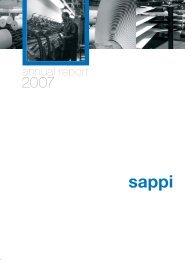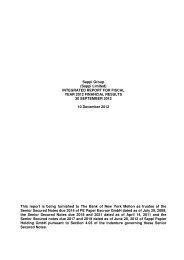SAPPI LTD (SAP) 6-K
SAPPI LTD (SAP) 6-K
SAPPI LTD (SAP) 6-K
Create successful ePaper yourself
Turn your PDF publications into a flip-book with our unique Google optimized e-Paper software.
Goodwill that arose prior to 1 January 2004, has been recognised as an intangible asset and amortised in line with Finnish GAAP over 20 years until 31<br />
December 2003. Effective with the transition to IFRS, goodwill is considered to have an indefinite useful life and is not subject to amortisation. Goodwill is<br />
carried at cost less impairment losses and is tested for impairment at least annually and whenever events or changes in circumstances indicate that the carrying<br />
amount may not be recoverable. Any impairment loss is recorded as an expense in the income statement in the reporting period during which the impairment<br />
has been determined. For impairment testing, goodwill is tested at the Company level as management determined that the Company represents the lowest<br />
level cash generating unit where assets generate cash inflows that are largely independent of the cash inflows from other assets or group of assets. An<br />
impairment loss is recognised when the recoverable amount of the cash-generating unit is less than the carrying amount of that unit. The recoverable amount<br />
of a cash-generating unit is determined by the higher of the following values: Fair value less costs to sell or value in use. An impairment loss is allocated first<br />
to any goodwill of the cash generating unit and then to the other assets of the unit on a pro-rata basis based on the carrying amount of each asset in the unit.<br />
An impairment loss recognised on goodwill may not be reversed in subsequent periods.<br />
M-real’s other historical acquisitions of Company entities, also accounted for under Finnish GAAP preceding the transition to IFRS, did not result in the<br />
recognition of goodwill.<br />
Other intangible assets<br />
The cost of patents, licenses and trademarks having a finite useful life is capitalised in the combined balance sheet under intangible assets and amortised on a<br />
straight-line basis over their useful lives in 5-10 years.<br />
Emission rights<br />
Allowances received by the governments free of charge have initially been recognised as intangible assets and the corresponding government grant as advance<br />
payment in liabilities based on fair value at the date of initial recognition. Allowances are measured at its cost or at their fair value if less. Allowances are not<br />
amortised. The emissions produced are recognised as cost and as liability together with the corresponding government grant as income both based on the<br />
value at the date of initial recognition. So rights consumed that are within the original range have no positive or negative effect on profit for the period. The<br />
costs of purchasing additional rights to cover excess emissions or the sale of unused rights have no effect on the financial result.<br />
Impairment of long-lived non-financial assets<br />
Assets that are subject to depreciation and amortisation (tangible fixed assets and intangible assets with definite useful lives) are reviewed for impairment<br />
whenever events or changes in circumstances indicate that the carrying amount may not be recoverable. An impairment loss is recognised for the amount by<br />
which the carrying amount of the asset exceeds its recoverable amount, which is the higher of an asset’s fair value less costs to sell or its value in use. Value<br />
in use is calculated based on estimated future cash flows expected to result from the use of the asset For the purposes of assessing impairment, assets are<br />
grouped at the lowest levels of cash generating units for which there are separately identifiable cash flows which was determined to be at the level of the<br />
Company. For assets other than goodwill, an impairment loss is reversed only to the extent that the asset’s carrying amount does not exceed the carrying<br />
amount that would have been determined, net of depreciation or amortisation, if no impairment loss had originally been recognised. A previously recognised<br />
impairment loss may only be reversed if there has been a change in the estimates used to determine the asset’s recoverable amount since the last impairment<br />
loss was recognised.<br />
Provisions<br />
A provision is recognised in the combined balance sheet when the Company has a legal or constructive obligation as a result of a past event and it is probable<br />
that an outflow of resources embodying economic benefits will be required to settle the obligation and a reliable estimate can be made of the amount of the<br />
obligation. If some or all of the expenditure required to settle a provision is expected to be reimbursed by another party, the reimbursement is recorded in the<br />
combined balance sheet as a separate asset, but only if it is virtually certain that reimbursement will be received.<br />
69
















